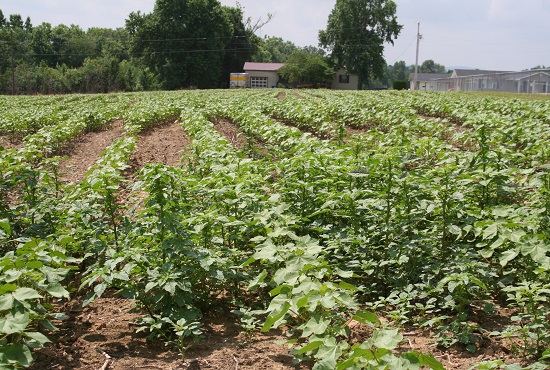Biotech Update
By the year 2050, the world population will have increased by some 3 billion souls, up to 9 billion people, and global demand for fiber will increase four to five fold.
The challenges facing global cotton production in the coming years are many: limited arable land and water; competition for land with food; feed and energy crops; environmental and ecological pressures (such as biodiversity and climate change); changing customer needs; rapidly evolving technologies; and last but not least, sustainability considerations.
If the cotton industry is going to meet these challenges, it is essential to make cotton production more efficient and sustainable. To achieve this, we need an integrated approach that includes solutions ranging from seeds with higher yield potential, to optimized crop input management and new crop protection solutions.
Advancements in Seed Breeding and Biotechnology
Cotton breeders have made remarkable progress in increasing crop yields for over a century. Between 1961 and 1995, cotton lint yield increased 1.98% per year.
However, plant breeders must continually work to achieve their goals and respond to changing customer needs and market demands. For example, changes in agricultural practices might drive the need for developing genotypes with specific agronomic characteristics. Environmental factors are also constantly changing and can pose new challenges for breeders to develop genotypes with resistance to new or evolved pests, growing conditions or disease pressures.
Plant breeders therefore face the endless task of continually developing new crop varieties that both incorporate desirable characteristics and deliver yield gains expected by farmers.
However, despite the 7-9 kg/ha/yr gains in lint yield observed so far, it is clear that we will not be able to meet future projected demands without boosting yields even more. Biotechnology platforms are required, in conjunction with molecular breeding techniques, to answer the increased global demand foreseen for cotton.
In 2010, according to the International Service for the Acquisition of Agri-Biotech Applications (ISAAA), biotech cotton represented as much as 64% of the global cotton area, being used on around 21 million hectares in both industrial and developing nations. Biotech cotton has been widely embraced by farmers since its introduction in 1996 and is currently being adopted by Central and Latin American countries very quickly, as well as countries such as Pakistan and Burkina Faso. Other African countries likely will adopt this technology in the coming years. India has the largest biotech cotton area with 9.4 million hectares planted by 6.3 million farmers.
Before the introduction of biotechnology in cotton in the mid 1990s, conventional breeding contributed roughly 7-9 kg/ha/yr average gains in lint yields. However, combined with conventional breeding, the adoption of biotechnology has sped up the rate of world lint yield gains between 1996 and 2008, resulting in a 14 kg/ha/year average increase.
Today, two primary types of genetically modified agronomic traits are commercialized in cotton and available to farmers: insect resistance traits for Lepidopteran control, and herbicide tolerance traits for weed management. Since 1996/97, five insect resistant (IR) products and five herbicide tolerant (HT) products have been approved and commercialized for cotton:
- IR products: Bollgard 1 (Monsanto), Bollgard 2 (Monsanto), Fusion gene (CAAS, China), XGene – Event 1 (JK Seeds, India), Widestrike (Dow Agroscience)
- Herbicide-tolerant products: BXN (tolerance to bromoxynil, Rhone Poulenc Agriculture), Roundup Ready (Monsanto), Roundup Ready Flex (Monsanto), Liberty Link (Bayer CropScience), GlyTol (Bayer CropScience.
Increasingly important to farmers is the availability of stacked or combined technologies, which deliver a greater spectrum of activity (depending on the individual components of the stack) and even more benefits to the farmer.
The primary or direct benefits of biotech cotton so far have been an improvement of crop management; a reduction in production costs; an improvement of yield and profitability for the farmer; the possibility to grow cotton on areas where it would no longer be possible using conventional crop protection tools; an optimized use of chemicals; a reduction in sprayings (and consequently in fossil fuel use); and a reduction in farming risks.
The indirect benefits of GM cotton have been a reduction of labor costs; an improvement in the population of beneficial insects and wildlife; an improvement of the quality of air and of the soil; less water waste and soil erosion; less labor time (which can be dedicated to other activities); and an improved economic outlook for the cotton industry.
New Traits of Interest
Compared with crops like corn or soybeans, cotton has one of the most innovative track records for biotechnology applications. By 2015, there could potentially be up to 27 commercialized events in the marketplace in the areas of herbicide tolerance and insect resistance – a key focus of most corporate research pipelines for the next four to five years.
However, for the 2015-2020 period and beyond, it is anticipated that the range of biotechnology applications will broaden significantly, with new biotechnology developments for cotton focused on yield increase, stress tolerance (e.g., drought, water use efficiency, novel Lepidopteran and sap-sucking insect control, nematode control, disease resistance, novel herbicide tolerance) and fiber quality.
Water use efficiency and nitrogen use efficiency are among the most exciting technologies with potential to reach the market in the mid-term. Research efforts are focused on exploring ways to increase cotton yields using the same amount or less water or fertilizer inputs, thereby reducing cotton’s resource needs and improving its long-term sustainability profile.
To solve water challenges, we can improve the efficiency of irrigation systems but we can also try to improve plants’ use of available water. In this respect, biotechnology experts and breeders are making some progress developing new varieties of cotton that require less precious liquid yet still produce high yields and good quality fibers.
In the area of nitrogen utilization, the use of synthetic nitrogen fertilizers in crop production typically results in significantly more nitrous oxide (N2O) emissions. One of the consequences is that increased N2O impacts climate change. Solutions to the fertilizer efficiency challenge include increasing the nitrogen use efficiency in crops.
This can be accomplished through changes in management (conservation tillage, timing of fertilizer application) and also through fertilizer technology and genetic improvements of crops. Biotech crops have the potential to contribute to the closing of the production gap through improving yields with lower inputs of water and fertilizers.
Fiber Quality Enhancements
The ultimate cotton improvement objective is fiber quality. Researchers looking at engineering the cotton fibers themselves to deliver certain quality characteristics that might be desirable to spinners are making great strides.
The primary focus is to understand the mechanisms in the plant that control fiber initiation and elongation, and bring about improved fiber formation and length either through molecular breeding or by genetic modification.
Bioengineered fibers with certain properties could add value to weaving and textile processing and ultimately could be of real value to the consumers. With this field of application, the benefits for biotechnology will not stop at the farm gate, but will impact the entire value chain and will offer benefits from seeds to fabrics.
One potential application of bioengineered fibers is improved dyeability. Because of the poor reactivity of cotton with chemicals (cotton fiber and dye have the same electric charge and tend to magnetically repel), dyeing cotton is a very expensive processes that requires high energy and water consumption.
These challenges might be addressed by novel bioengineered cotton fibers. By modifying the reactivity of cotton (i.e., changing the fiber charge), it is possible to create cotton fiber that is more reactive to dyes. Early research has already shown that this modified fiber can improve dyeability, although the technology is still years away.
To date, biotechnology has delivered valuable farmer benefits, with insect resistance and herbicide tolerance allowing growers to effectively and efficiently manage pests and weeds. At the same time, other promising applications of biotechnology are in the pipeline and should be available to farmers in the medium and longer term:
- In the next technological wave (2016-2020), additional insect control (other than lepidopteran), drought tolerance and water use efficiency, yield enhancement are anticipated.
- In the subsequent wave (2021-2025), nematode control, disease resistance, heat and salinity tolerance, nitrogen use efficiency, improved fiber quality and bioengineered fibers could be expected.
Cotton production continues to benefit from the application of biotechnology, including genetic modification. The improvements might take 10 to 15 years, but in the shorter term (5 to 10 years), biotechnology will continue to be applied in order to increase yield and reduce costs, to the benefit of industrial and farm segments.








